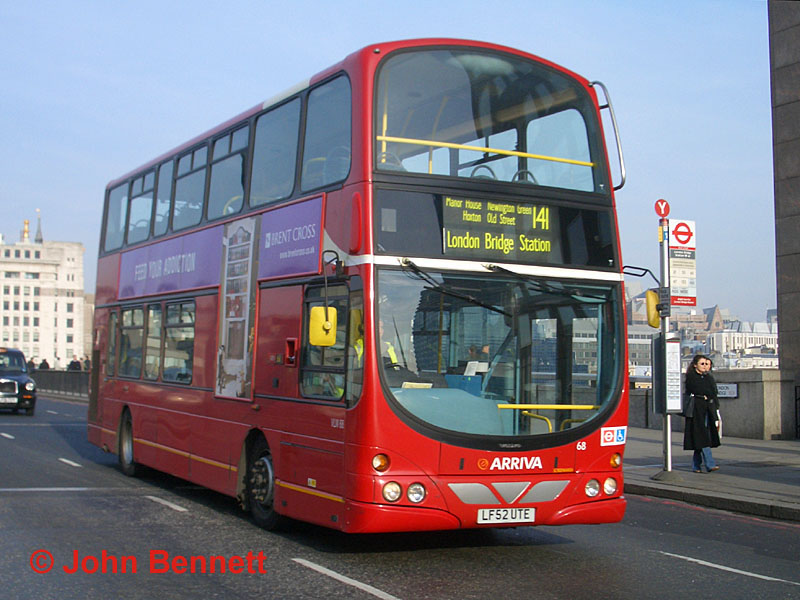 | Photo © John Bennett. |
Home | Bus routes | Operational details | Service changes | Operators & Garages | Photo gallery
Route 141 is currently home to a bewildering array of vehicle types. The most common type is the Wright Eclipse Gemini bodied Volvo B7TL, with no fewer than 85 members of the type based at Wood Green garage, the route's home base. These are actually numerically the first 85 of the class, including the prospective initial order for 50, but some were originally based at Palmers Green garage. VLW68 (LF52 UTE) nears journey's end at London Bridge on Tuesday 24 January 2006. From the shadow one would ascertain that it is around 1 PM. A few hours later this spot would be heaving with commuters heading for London Bridge station, and this bus would likely be carrying a heavy load!
 | Photo © John Bennett. |
A one-off on the 141, and probably not for much longer, is the prototype hybrid VDL DB250, HEV1 (LJ07 ECE), seen at Bank on Tuesday 13 January 2009 heading northbound. This was the first hybrid double decker and has spent considerable periods off the road under test. The green leaf livery is now becoming familiar as hybrids become more common around London.
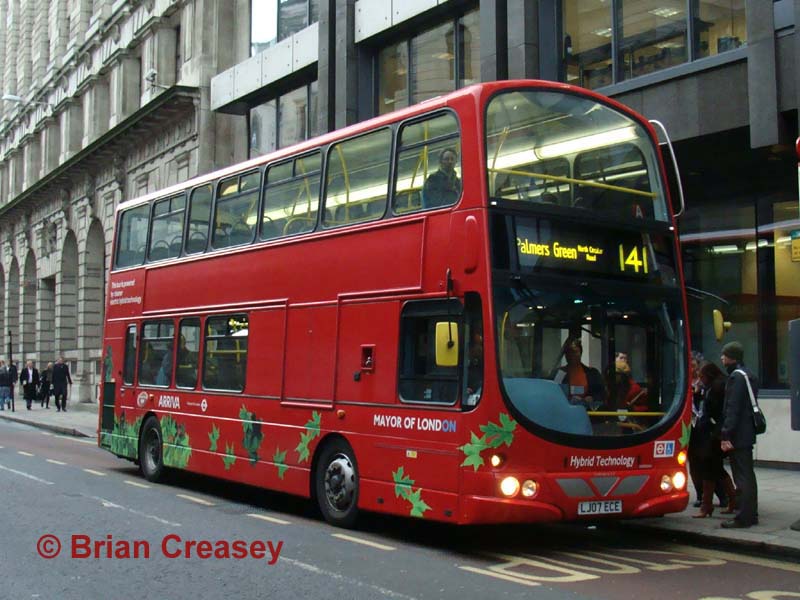 | Photo © Brian Creasey. |
The bodywork is again by Wright to a similar design, dubbed Pulsar Gemini. The Gemini suffixes (Latin for twin [deck] – better known as the third sign of the zodiac) have been used to denote double deck bodies, with a single deck bus from the same chassis manufacturer using the same name without Gemini – for instance the Wright Eclipse is the body for the Volvo B7L.
The 141 is becoming something of a hotbed of hybrid activity, with two larger batches of hybrids coming to join HEV1. First into service are the HV class which are based on Volvo B5L chassis. To confuse matters the body design is merely the Wright Gemini, but with Gemini 2 styling at the rear, and is already defunct – see the following picture! HV4 (LJ09 KOU) pulls out of London Bridge bus station on Wednesday 1 July 2009. The office block in the background is about to be demolished to make way for the "shard of glass," destined to be, for a short while at least, the tallest building in London.
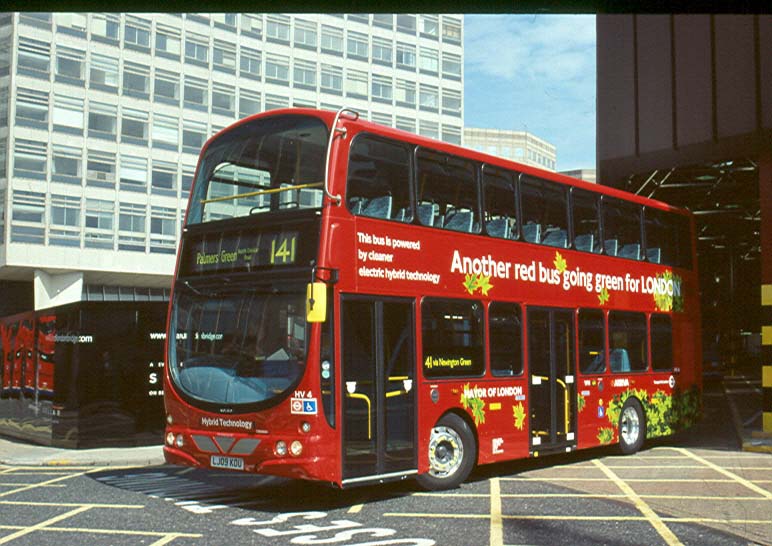 | Photo © Graham Harris. |
The HVs are the first double deckers equipped with a parallel hybrid drive system, which is deemed more suitable for interurban work as the engine drives the wheels directly and is merely assisted by battery power at low speeds. Most hybrid buses have the series arrangement in which the engine merely charges the batteries which in turn provide all the power to the electric motors on the wheels. A third combination of hybrid for the 141 will be the HW class of Wrightbus Gemini 2s, which have VDL running components and hence are more similar to HEV1, though no doubt with the most up-to-date technology.
However, a large batch of conventionally engined versions of the same combination is currently in course of delivery for route 38, and are temporarily being used on the 141. DW201 (LJ09 KRO), the first of the batch, is seen on Thursday 13 August 2009 approaching Wood Green Station down Jolly Butcher's Hill. As noted above these are to the new Gemini 2 design, and the re-designed front can be contrasted clearly with the older buses shown above. The class code is shared with Pulsar Gemini bodied DB250LFs, but a clean break has been made in the numbering.
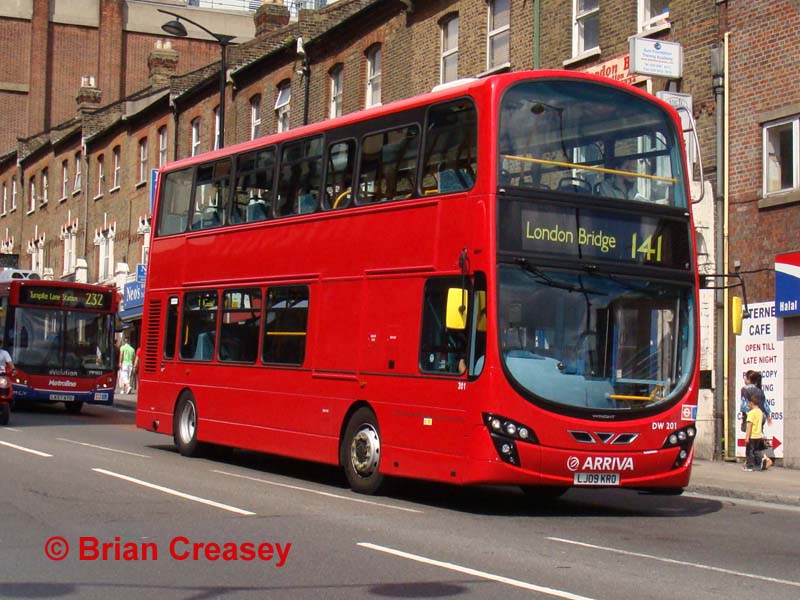 | Photo © Brian Creasey. |
A few older buses are still liable to appear on the 141 from time to time, so a couple of samples have been included for completeness. DLP50 (LJ51 DJU) is a Plaxton President bodied DAF DB250LF and was seen in King William Street about to cross London Bridge at the end of a trip from Palmers Green, again on Tuesday 24 January 2006. The photo dates from a time when Wood Green and Palmers Green had a joint vehicle allocation, with only light maintenance done at the latter garage. They have now been split up with the majority of DLPs, including this one, going to Palmers Green – but a few DLPs remain at Wood Green.
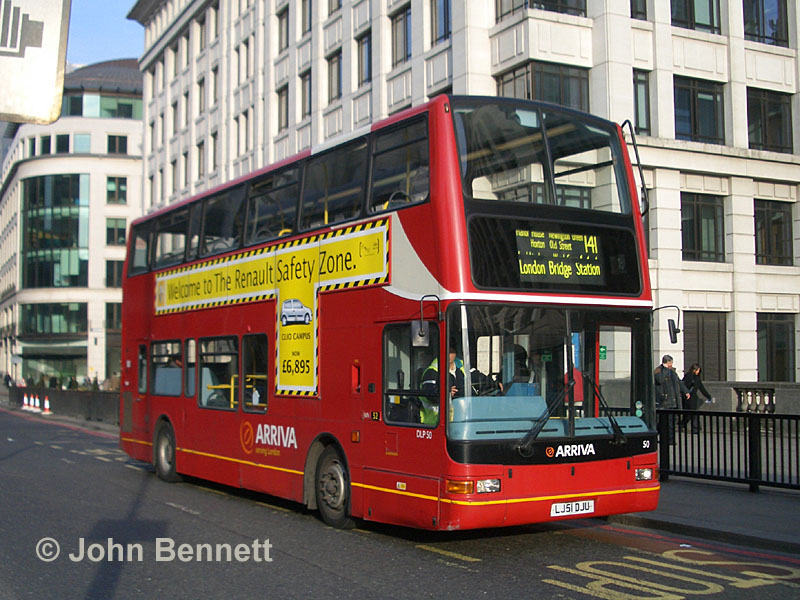 | Photo © John Bennett. |
As with the earlier photos, the almost complete absence of passengers will be noted: this is a result of TfL's policy to operate peak frequency levels between the peaks. Whilst this improves vehicle and driver utilisation (in theory, at least), the benefits of doing so must be called into question as clearly there are far fewer passengers travelling at those times, especially on routes such as this one serving the City of London.
I have really had to delve into the archives to find a picture of the final type of bus that may appear on the 141. Those are the DLA class of Alexander ALX400 bodied DAFs. Though more common than the DLPs, Wood Green garage now only has a handful and they are mostly relegated to use on school routes. DLA22 (S322 JUA) crosses the intersection at Manor House on Thursday 11 April 2002; this particular vehicle is now a training bus at Clapton.
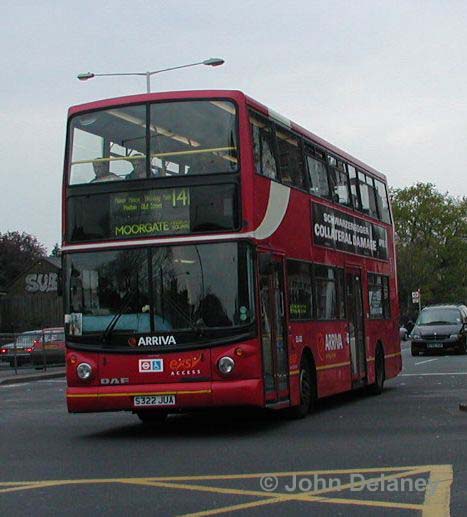 | Photo © John Delaney. |
One clue to the age of this photo is the ultimate destination of Moorgate, which indeed was the regular terminus until a couple of months after the photograph was taken. At the time the route was at its shortest extent, running only between Wood Green and Moorgate with an extension to Liverpool Street station on Sundays. It has since been extended at both ends, to London Bridge from 1.6.02 and to Palmers Green (North Circular Road junction) on 14.1.06 – the latter in conjunction with the artic conversion of route 29.
If one goes back then the 141 was once a very long route indeed, being an amalgamation of present day routes 141 and 172. The routeing across the City was different however: after Moorgate buses ran via London Wall, St. Paul's and Blackfriars to Elephant & Castle. The route started in November 1961 generally running in two sections, Winchmore Hill – Moorgate (operated by Wood Green garage) and Wood Green (or Turnpike Lane Station) – Grove Park (operated by New Cross). The latter section ran on Mondays to Fridays only; on Saturdays and Sundays there was a route 141A (Grove Park – Finsbury Park via routes 141 and 4 – the remnants of old route 179).
The 141 ceased to operate north of Wood Green in September 1968, when its role out to Winchmore Hill was taken over by route W4 as part of the Wood Green area flat fare scheme. The southern leg of the route was curtailed to Newington Green. The 141A was withdrawn on Sundays from October 1969, and an additional section of the 141 was introduced on Sundays between Grove Park and New Cross Gate, subsequently reduced from October 1970 to Catford garage to New Cross. This led to the very strange situation of a service being provided at both ends of the route, with nothing in the middle! The southern section was withdrawn on Sundays in January 1972, but not before a similar arrangement was introduced on Saturdays from September 1971 following the complete withdrawal of the 141A, with an isolated southern section running between Grove Park and Elephant & Castle (with some journeys to Farringdon Street). A through service was introduced on Saturdays as part of Bus Plan in October 1978.
Having been Routemaster operated, with an interlude of DMS Fleetlines from 1977 to 1982, Leyland Titans were introduced on the New Cross allocation from 25/07/84, initially in two person operated mode except on Sundays. Wood Green's allocation gained Metrobuses from 02/02/85 and the whole route was converted to one person operation. A Monday to Friday allocation was added from Catford from 16/08/86, but removed from 27/04/91. The modest overlap, between Newington Green and Moorgate, was always rather an anomaly, but the through service on Saturdays, said to be to facilitate shopping trips to Wood Green, also provided welcome variety with Wood Green Metrobuses delving far into South London Titan territory and New Cross's Titans doing the same for the north's Metro-land!
The lack of a through service on the 141, other than on Saturdays, persisted until 1 February 1992, when the route was cut in half at Moorgate, with the southern leg renumbered 172; subsequent history of that portion is detailed on that route's own page. The residual portion of the 141 was awarded under tendering to Grey Green, which introduced some very strange looking, but comfortable, East Lancs re-bodied Volvo B10Ms. Being coach chassis, the rear overhang was cut off to make them suitable for use as buses, meaning the rear wheels were right at the back, rather than being inset as would be more usual! All a far cry from the purpose-built London-spec buses of today. After Grey Green and Leaside came together under Cowie/Arriva ownership, the 141 was moved back to Wood Green in June 1998 to make room for route 188 at Stamford Hill (SF) garage.
Navigation
| Previous | Next | |
| Chronologically | 344 | 86 |
| Numerically | 140 | 144 |
Photo Gallery | Bus route list | Operational details | Service changes | Operators & Garages